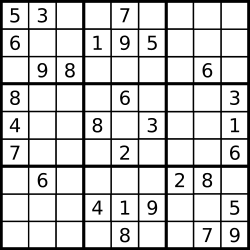題目
題目連結:https://leetcode.com/problems/sudoku-solver/
給一個數獨,保證存在唯一一組解,求出數獨。
範例說明
A sudoku puzzle:
![]()
The sudoku puzzle solution:
![]()
想法
解數獨最簡單的方法為回朔法。所謂回朔法其實就是利用遞迴暴力嘗試,對於每一個數獨的空格,都暴力嘗試填入 1 ~ 9。若發現填不下去了,則返回到上一步嘗試填入下一種數字。
當然,若要解的數獨比九乘九大小更大,可以將數獨轉換為精準覆蓋問題,再利用舞蹈鏈求解。(待補)
實作細節
實作上,遞迴函數 solver 攜帶 x, y 代表當前位置。如果當前位置為數字則跳過,否則嘗試填入 1 ~ 9。
填入數字 i 時檢查此位置是否能夠填入,所以只要檢查:
- 第
x 列(row)是否有 i。
- 第
y 行(column)是否有 i。
(x, y) 所在的方格(block)內是否有填入 i。
若我們將方格編號,由左到右、由上到下為 0 ~ 9 號,則 (x, y) 所在的方格編號為 x / 3 * 3 + y / 3。
檢查數字可以使用迴圈檢查,或是額外紀錄布林值陣列 row[i][j], col[i][j], block[i][j] 分別代表第 i 個列、行、方格有沒有數字 j。
當然,要額外紀錄陣列就必須在初始化時先遍歷整個數獨,但是在檢查時可以 O(1) 知道數字能否填入。
不額外紀錄陣列雖然程式碼較簡潔,但速度稍慢一些。
在 (x, y) 填入數字 i 後,向下一格遞迴。不要忘記在遞迴返回後恢復原本的盤面(在呼叫函數後的下一行)。
若有額外紀錄 row, col, block 陣列,填入數字時要將 row[x][i], col[y][i], block[x / 3 * 3 + y / 3][i] 改為 true,遞迴返回後,這些值也要恢復成 false。
最後,遞迴的終止條件為 x = 9,代表所有格子已經填完。
另外要注意 board 內存的為 char,轉為對應數字時應該要剪去字元的 ASCII 編碼。
程式碼
不額外紀錄 row, col, block
1
2
3
4
5
6
7
8
9
10
11
12
13
14
15
16
17
18
19
20
21
22
23
24
25
26
27
28
29
30
31
32
33
34
35
36
37
38
39
40
41
42
43
44
45
46
47
|
class Solution {
private:
bool solver(int x, int y, vector<vector<char>>& board) {
if (x == 9) return true;
int nextX = y == 8 ? x + 1 : x;
int nextY = y == 8 ? 0 : y + 1;
if (board[x][y] == '.') {
for (int i = 1; i <= 9; i++) {
bool valid = true;
char cell = i + '0';
for (int j = 0; j < 9; j++) {
int blockX = (x / 3) * 3 + (j / 3);
int blockY = (y / 3) * 3 + (j % 3);
if (board[x][j] == cell || board[j][y] == cell || board[blockX][blockY] == cell) {
valid = false;
break;
}
}
if (!valid) continue;
board[x][y] = cell;
if (solver(nextX, nextY, board)) return true;
board[x][y] = '.';
}
} else {
return solver(nextX, nextY, board);
}
return false;
}
public:
void solveSudoku(vector<vector<char>>& board) {
solver(0, 0, board);
}
};
|
額外紀錄 row, col, block 三個布林值陣列
1
2
3
4
5
6
7
8
9
10
11
12
13
14
15
16
17
18
19
20
21
22
23
24
25
26
27
28
29
30
31
32
33
34
35
36
37
38
39
40
41
42
43
44
45
46
47
48
49
50
51
52
53
54
55
56
57
58
59
60
61
62
63
|
class Solution {
private:
bool row[9][9], col[9][9], block[9][9];
inline void toggleState(int x, int y, int i) {
row[x][i] ^= true;
col[y][i] ^= true;
block[x / 3 * 3 + y / 3][i] ^= true;
}
bool solver(int x, int y, vector<vector<char>>& board) {
if (x == 9) return true;
int nextX = y == 8 ? x + 1 : x;
int nextY = y == 8 ? 0 : y + 1;
if (board[x][y] == '.') {
for (int i = 0; i < 9; i++) {
if (!row[x][i] && !col[y][i] && !block[x / 3 * 3 + y / 3][i]) {
board[x][y] = i + '1';
toggleState(x, y, i);
if (solver(nextX, nextY, board)) return true;
toggleState(x, y, i);
board[x][y] = '.';
}
}
} else {
return solver(nextX, nextY, board);
}
return false;
}
public:
void solveSudoku(vector<vector<char>>& board) {
memset(row, false, sizeof row);
memset(col, false, sizeof col);
memset(block, false, sizeof block);
for (int i = 0; i < 9; i++) {
for (int j = 0; j < 9; j++) {
if (board[i][j] != '.') {
int cell = board[i][j] - '1';
row[i][cell] = true;
col[j][cell] = true;
block[i / 3 * 3 + j / 3][cell] = true;
}
}
}
solver(0, 0, board);
}
};
|

